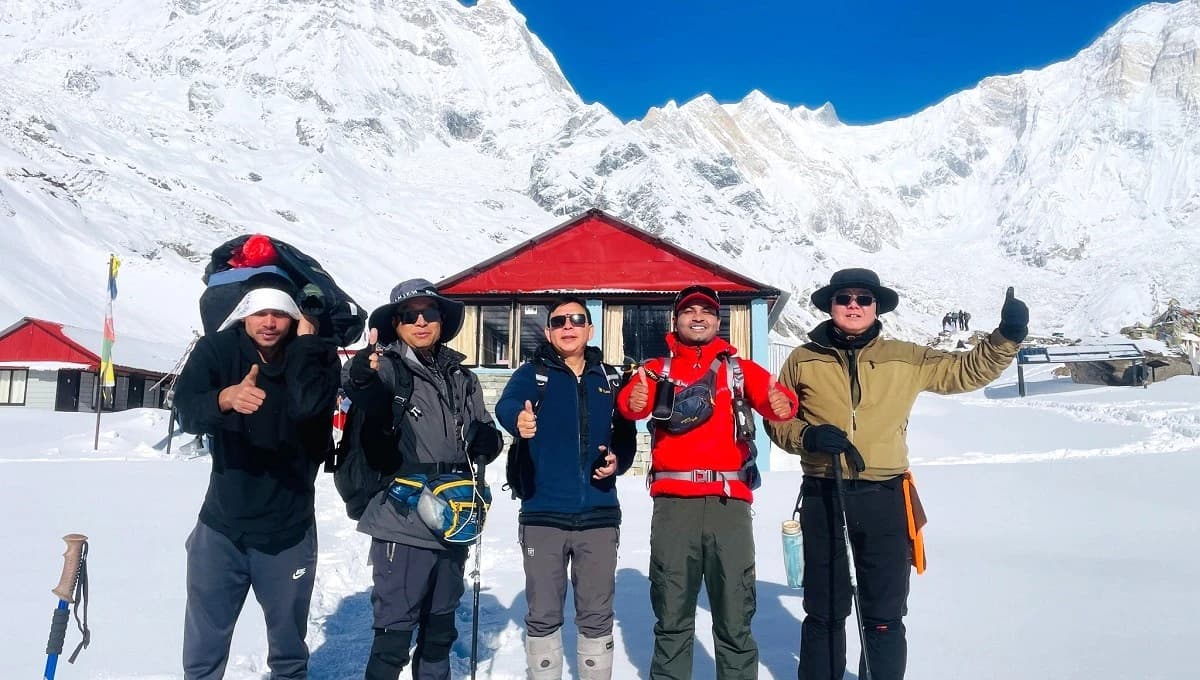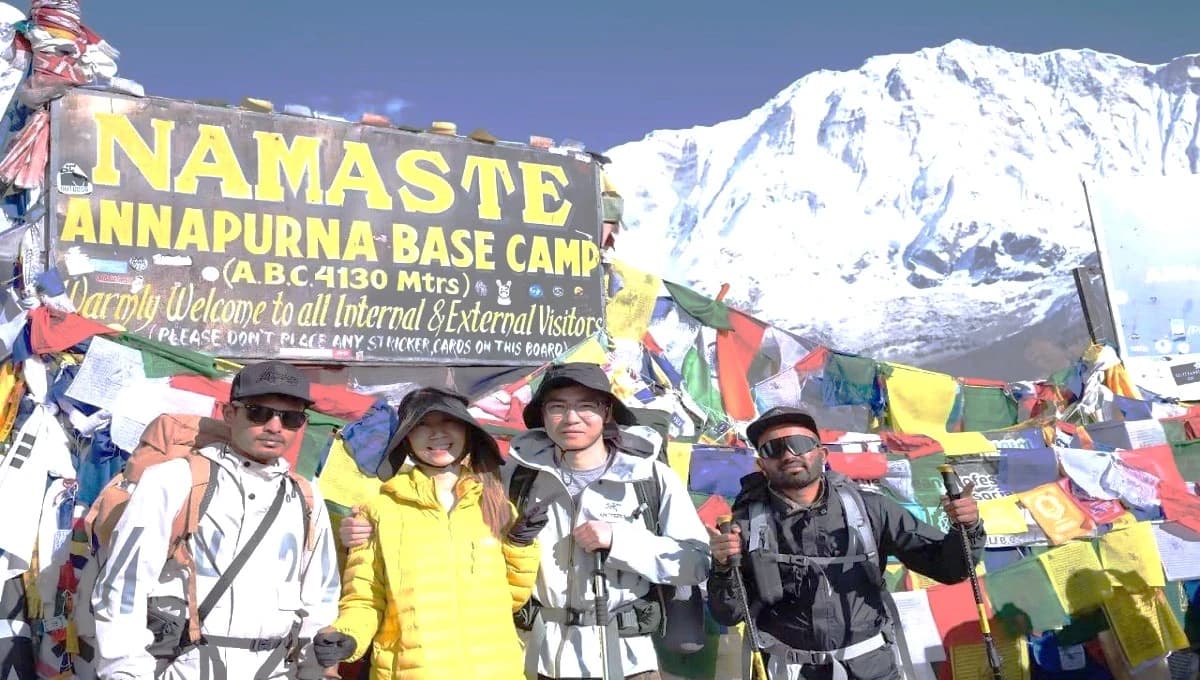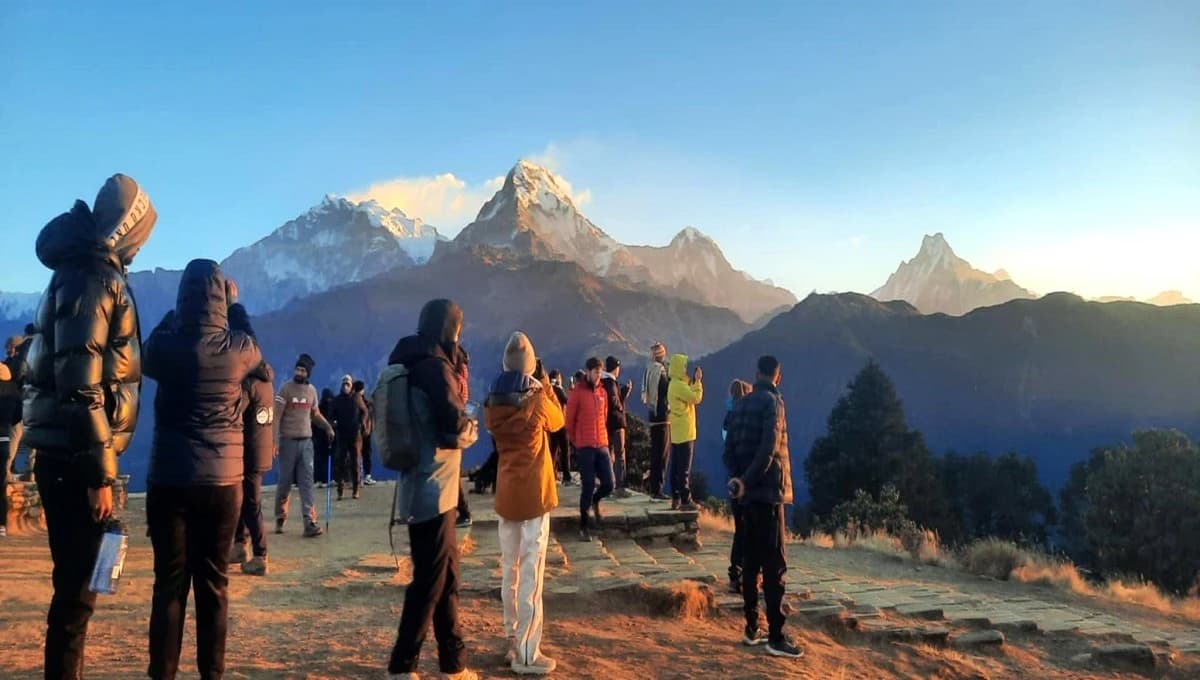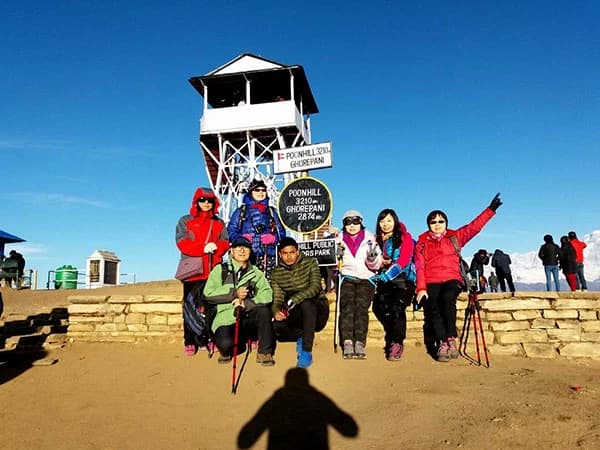The Annapurna Base Camp Trek via Poon Hill offers a unique mix of natural beauty, cultural riches, and varied landscapes in the heart of the Annapurna.
This adventure combines two popular trekking destinations in the region – Ghorepani Poon Hill, renowned for a surreal sunrise and Mountain View, and Annapurna Base Camp, situated in the Annapurna sanctuary. This trek is an excellent option for trekkers looking for a rewarding Himalayan adventure that balances challenge and comfort.
Highlights of the Annapurna Base Camp Trek via Poon Hill
Sunrise and Himalayan Panorama from Poon Hill
- You will enjoy breathtaking sunrise views over the Annapurna and Dhaulagiri ranges from Poon Hill (3,210 m).
- It is one of the most popular viewpoints for trekkers in the Annapurna.
Diverse Himalayan Scenery
- You can enjoy the dramatic landscapes from terraced fields to rhododendron forests and alpine meadows to glacier moraines.
- It brings a chance to enjoy spectacular close-up views of mountains like Annapurna I (8,091 m), Machapuchare (Fishtail), Hiunchuli, and Dhaulagiri.
Varieties of Flora and Fauna
- You will trek through lush rhododendron and bamboo forests along the trail.
- The trail offers a high chance of spotting diverse wildlife
Rich Cultural Immersion
- As you trek in the region, you will enjoy charming Gurung and Magar villages like Ghorepani, Tadapani, Chhomrong, and Jhinu.
- You will love the warm hospitality, local traditions, and unique mountain lifestyle in the region.
Natural Hot Spring Bath
- You can take a natural hot spring bath at Jhinu Danda at the end of the trek. It will help you relax after days of walking up and down the mountains.
Doing the Trek Classic Way
- This route of the adventure is the classic trail that trekkers to Annapurna Base Camp would take. It offers a longer and richer trekking experience.
Annapurna Sanctuary
- When you reach the Annapurna Base Camp, you will stand at the heart of the Annapurna Sanctuary and enjoy towering mountains surrounding you.
What is the Best Time to Trek to Annapurna Base Camp via Poon Hill?
The best time to trek to Annapurna Base Camp via Poon Hill is during the spring (March to May) and autumn (September to November) seasons. The weather is generally clear, dry, and stable during these two seasons.
In spring, you will enjoy warm daytime temperatures, clear weather and beautiful sight of rhododendron blooms. It will be a colorful trekking experience in the region in spring season.
Autumn is another ideal season to trek in the region when you can experience crisp mountain air, awesome surroundings, and spectacular panoramic and close-up views of the mountains.
These seasons provide ideal trekking conditions, with pleasant temperatures and minimal risk of heavy rain or snowfall, making the journey safer and more enjoyable.
Annapurna Base Camp Trek via Poon Hill Itinerary
Our Annapurna Base Camp Trek via Poon Hill is a total of 15 days from arrival to departure. But here is the trekking only itinerary of the trip.
Trekking Itinerary
- Day 1: Drive from Pokhara to Nayapul, trek to Tikhedhunga (1,540 m): A short drive (1.5 hours) to Nayapul, followed by an easy trek along terraced fields and small villages to Tikhedhunga.
- Day 2: Tikhedhunga to Ghorepani (2,860 m): A challenging day climbing stone steps to Ulleri, then through rhododendron forests to Ghorepani.
- Day 3: Hike to Poon Hill (3,210 m) for sunrise, trek to Tadapani (2,630 m): Early morning hike to Poon Hill for breathtaking sunrise views over Dhaulagiri, Annapurna, and Machapuchare. Continue trekking through forests to Tadapani.
- Day 4: Tadapani to Chhomrong (2,170 m): Descend to Kimrong Khola, then ascend through Gurung villages to reach Chhomrong, gateway to the Annapurna Sanctuary.
- Day 5: Chhomrong to Dobhan (2,600 m): Descend and cross the Chhomrong Khola, then climb through bamboo and rhododendron forests to Sinuwa and continue to Dobhan via Bamboo.
- Day 6: Dobhan to Deurali (3,230 m): Trek through dense forest and past the Himalaya Hotel, with views of the glacial river below.
- Day 7: Deurali to Annapurna Base Camp (4,130 m): Ascend past Machapuchare Base Camp (MBC, 3,700 m) and enter the Annapurna Sanctuary, with panoramic views at ABC.
- Day 8: ABC to Bamboo: Retrace your steps, descending to Bamboo for an overnight stay.
- Day 9: Bamboo to Jhinu Danda (1,780 m): Trek back to Chhomrong, then descend steeply to Jhinu, where you can relax in natural hot springs.
- Day 10: Drive to Pokhara: Drive back to Pokhara marking the end of the trek.
How difficult is Annapurna Base Camp Trek via Poon Hill?
The Annapurna Base Camp Trek via Poon Hill is generally rated as moderate in difficulty. It’s one of Nepal’s more accessible and achievable Himalayan treks, but it still presents challenges that require preparation. Let us break it down:
Key Factors Affecting Difficulty
Altitude:
The highest point is Annapurna Base Camp at 4,130 meters (13,550 feet). While this is high enough for altitude-related symptoms, the risk of severe altitude sickness is lower compared to treks like Everest Base Camp (5,364m).
Daily walking hours:
Expect to trek 5–7 hours per day, with lots of ups and downs. The stone staircases, especially near Ulleri and Chhomrong, can be tiring.
Trail conditions:
The trail is well-established, with good teahouse infrastructure. However, there are steep ascents, descents, and sections that can be slippery during rain or snow.
Duration:
The trekking part only is of 10 days on this itinerary.The sustained effort over several days adds to the challenge.
Weather:
Conditions can change quickly, especially in the monsoon (slippery trails, leeches) and winter (snow, icy paths).
Who can do this Trek?
- Since this trek is a moderate adventure in difficulty, reasonably fit trekkers with right preparation can accomplish it.
- It is a walking adventure along the well-marked trail and does not require any technical climbing skills.
- If you are a regular hiker and can handle long uphill/downhill walks, it is easily manageable for you.
Tips to make it easier
Even if you are fit for the trek, you need to take a few things into consideration before embarking on the adventure.
- Train with cardio (hiking, running, cycling) and stair climbing before your trip.
- Ascend gradually, take rest days if needed.
- Stay hydrated and listen to your body.
- Trek during favorable seasons (spring: Mar–May; autumn: Sep–Nov).






